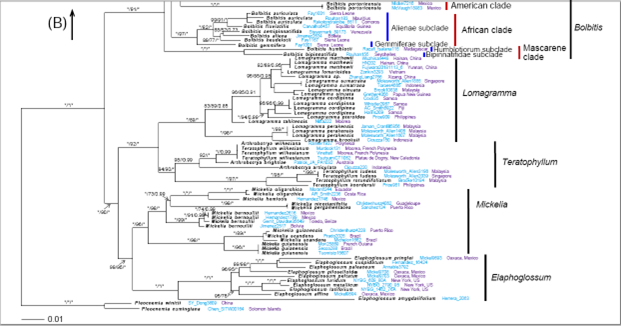The research on the phylogeny and biogeography of the genus Bolbitis
Recently, researchers of the Plant Science Research Center in South China Botanical Garden, Chinese Academy of Sciences, together with the Kunming Institute of Botany, Chinese Academy of Sciences, Shenzhen Orchid Plant Protection Research Center, Missouri Botanical Garden, under the support of the National Natural Science Foundation, have made new progress in the research on the phylogeny and biogeography of the genus Bolbitis. Related achievements were published in Molecular Phylogenetics and Evolution.
Bolbitis Schott is a pantropical genus, mainly distributed in Asia and Pacific islands. As an important component of understory vegetation, species of Bolbitis are terrestrial, lithophytic, or sometimes epiphytic on tree trunks, have creeping or shortly erect rhizomes, and usually grow in damp forest. Bolbitis is distinguished by often having strongly dimorphic fronds and proliferous buds adaxially on the apex of terminal segments. This genus was included within Bolbitidaceae, Elaphoglossaceae, Lomariopsidaceae, and presently widely accepted as a member of the subfamily Elaphoglossoideae of Dryopteridaceae.
Earlier studies confirmed the monophyly of Bolbitis when Mickelia is excluded and identified three major clades in Bolbitis. However, earlier studies are based on relatively small sampling and the majority of Asian species are not sampled.
The researchers mainly studied the genus Bolbitis in this study, and DNA sequences of three plastid markers of 169 accessions representing ca. 68 (85 % of total) species of Bolbitis, then Bayesian, maximum likelihood, and parsimony methods are used to infer a global phylogeny with a focus on Asian species. The result showed that species of Bolbitis were resolved into four major clades and their relationships were: the Malagasy/Mascarene clade was sister to the rest, followed by the African clade which was sister to the American clade + the Asian clade.
Combining fossil and geographic distribution data, BEAST and RASP were used to estimate the divergence time and reconstruct the ancestral distribution area of Bolbitis. The results showed that the genus Bolbitis originated in Africa and spread to Asia, and spread from Asia to the America through Africa recently, forming the current pattern of disjunction distribution in the pantropical region.
They further focused on the Asian fern genus Bolbitis and analyzed the possible reasons for its intra genus diversity formation. The results showed that Bolbitis can be divided into six six well-supported subclades: Heteroclitae subclade,Egenolfianae subclade,Sinuatae subclade,Quoyanae subclade,Bolbitianae subclade,Hekouenses subclade.
The lineage/species relationships within these subclades got a very good explanation overall, except Heteroclitae subclade and Quoyanae subclade. Among them, the two hybrid species, Bolbitis × laxireticulata and B. × multipinna recorded in literature, Yunnan spiny fern, came from Heteroclitae subclade and Quoyanae subclade respectively. Based on the morphological variations within the genus Bolbitis , they speculated that natural hybridization promotes the formation of diversity within the genus Bolbitis in East Asia.For the detailed information, please see http://dx.doi.org/10.1016/j.ympev.2022.107633

File Download: